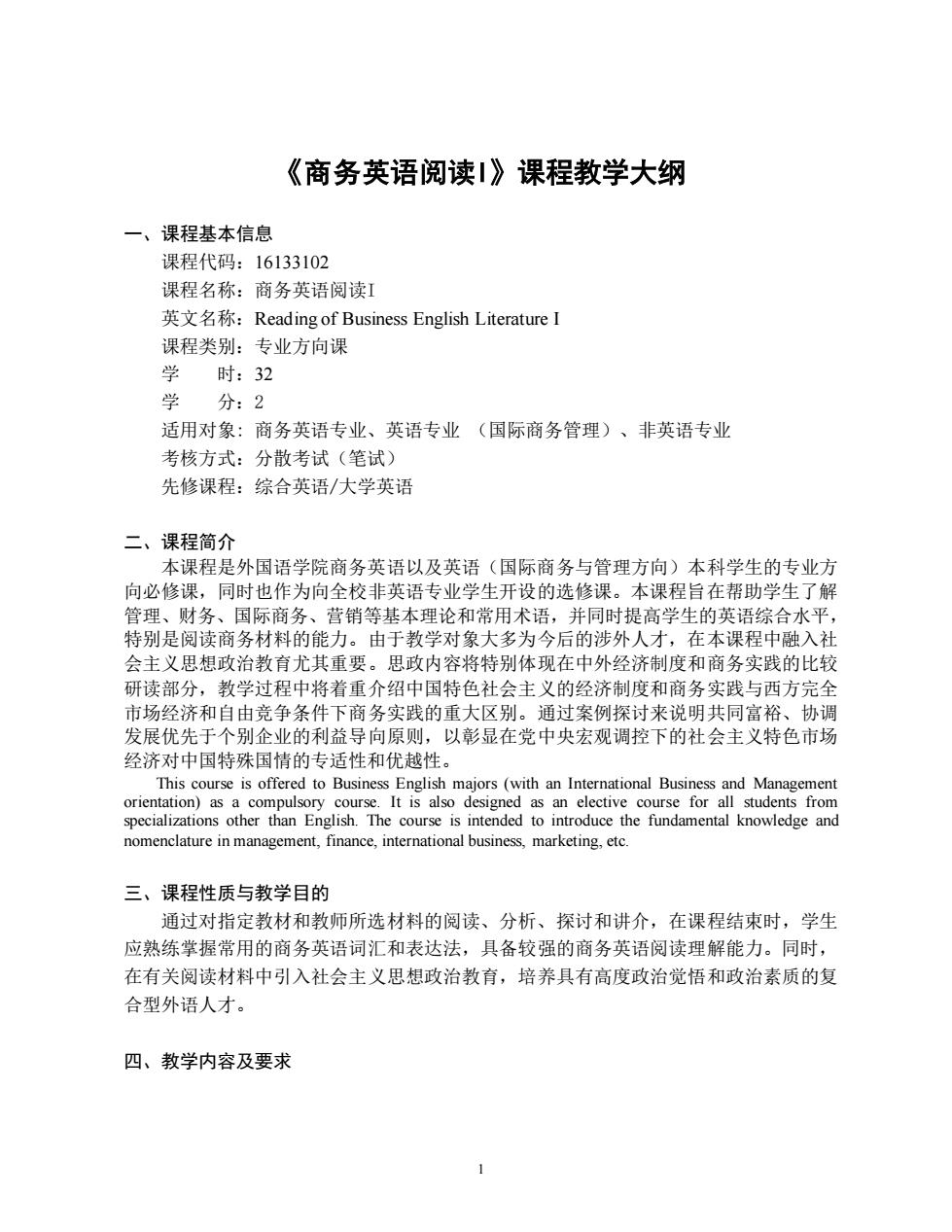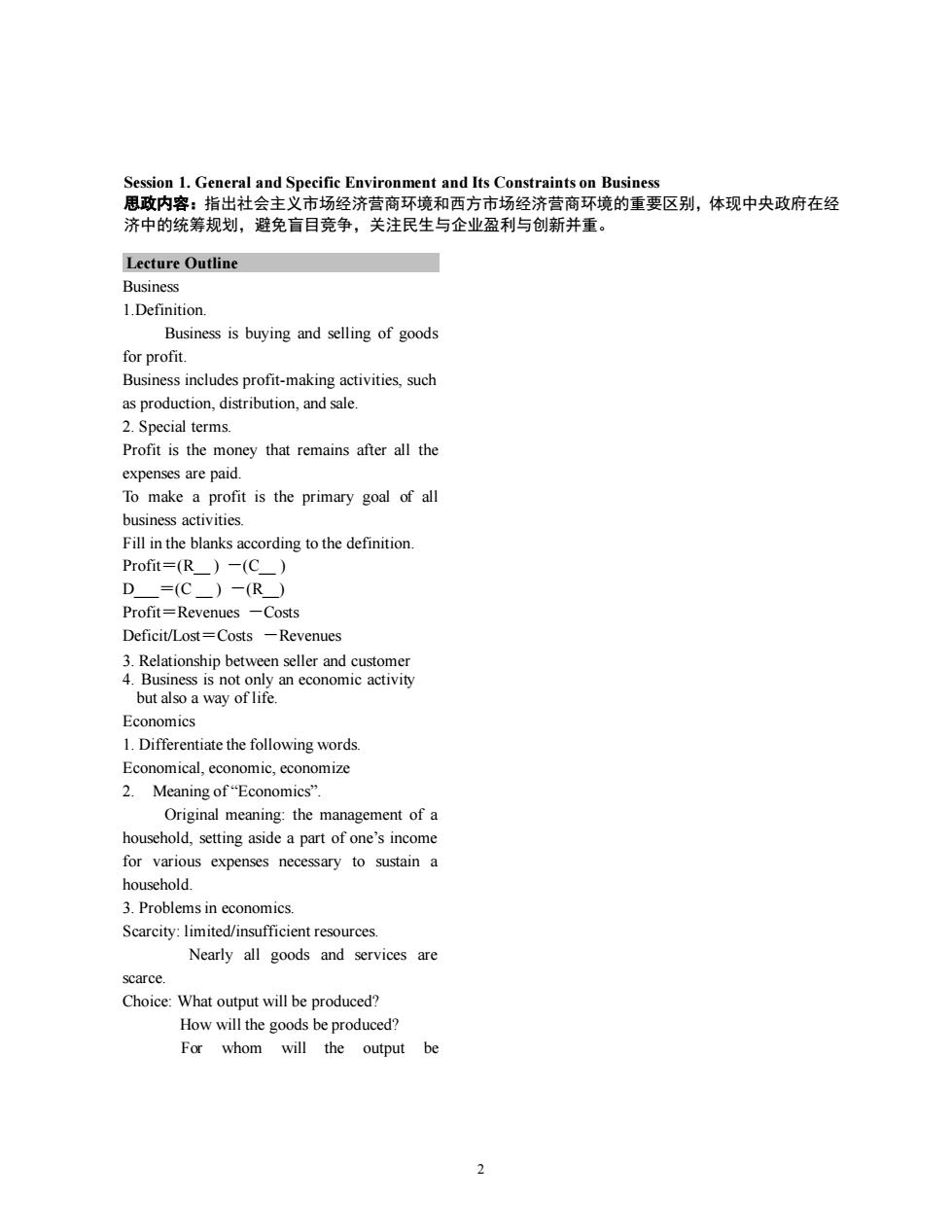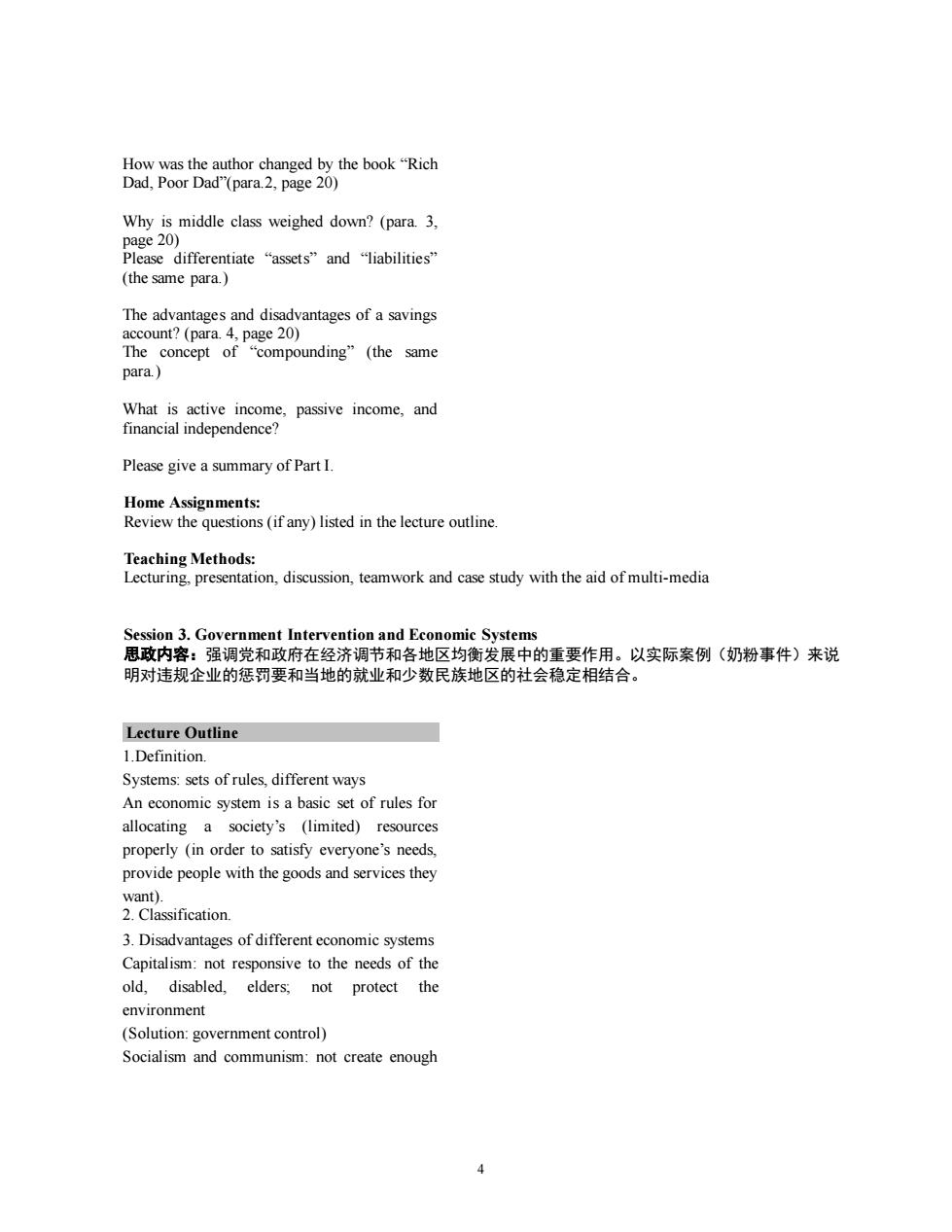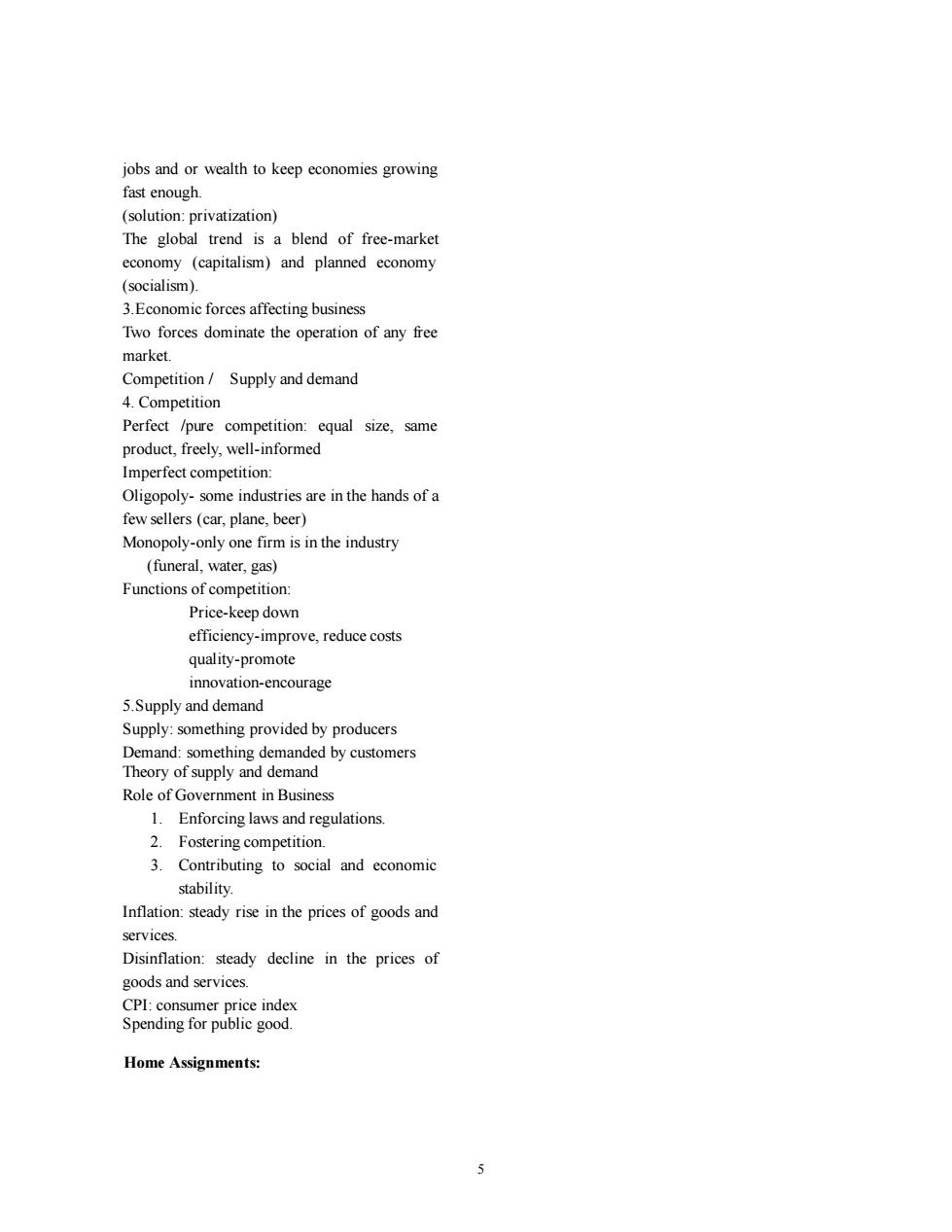
《商务英语阅读1》课程教学大纲 一、课程基本信息 课程代码:16133102 课程名称:商务英语阅读1 英文名称:Reading of Business English Literature I 课程类别:专业方向课 学 时:32 学 分:2 适用对象:商务英语专业、英语专业(国际商务管理)、非英语专业 考核方式:分散考试(笔试) 先修课程:综合英语/大学英语 二、课程简介 本课程是外国语学院商务英语以及英语(国际商务与管理方向)本科学生的专业方 向必修课,同时也作为向全校非英语专业学生开设的选修课。本课程旨在帮助学生了解 管理、财务、国际商务、营销等基本理论和常用术语,并同时提高学生的英语综合水平 特别是阅读商务材料的能力。由于教学对象大多为今后的涉外人才,在本课程中融入社 会主义思想政治教育尤其重要。思政内容将特别体现在中外经济制度和商务实践的比较 研读部分,教学过程中将着重介绍中国特色社会主义的经济制度和商务实践与西方完全 市场经济和自由竞争条件下商务实践的重大区别。通过案例探讨来说明共同富裕、协调 发展优先于个别企业的利益导向原则,以彰显在党中央宏观调控下的社会主义特色市场 经济对中国特殊国情的专适性和优越性 This course is offered to Business English majors (with an International Business orientatiot It is also ntal k tioge nce international business.market etc 三、课程性质与教学目的 通过对指定教材和教师所选材料的阅读、分析、探讨和讲介,在课程结束时,学生 应熟练掌握常用的商务英语词汇和表达法,具备较强的商务英语阅读理解能力。同时, 在有关阅读材料中引入社会主义思想政治教育,培养具有高度政治觉悟和政治素质的复 合型外语人才。 四、教学内容及要求
1 《商务英语阅读I》课程教学大纲 一、课程基本信息 课程代码:16133102 课程名称:商务英语阅读I 英文名称:Reading of Business English Literature I 课程类别:专业方向课 学 时:32 学 分:2 适用对象: 商务英语专业、英语专业 (国际商务管理)、非英语专业 考核方式:分散考试(笔试) 先修课程:综合英语/大学英语 二、课程简介 本课程是外国语学院商务英语以及英语(国际商务与管理方向)本科学生的专业方 向必修课,同时也作为向全校非英语专业学生开设的选修课。本课程旨在帮助学生了解 管理、财务、国际商务、营销等基本理论和常用术语,并同时提高学生的英语综合水平, 特别是阅读商务材料的能力。由于教学对象大多为今后的涉外人才,在本课程中融入社 会主义思想政治教育尤其重要。思政内容将特别体现在中外经济制度和商务实践的比较 研读部分,教学过程中将着重介绍中国特色社会主义的经济制度和商务实践与西方完全 市场经济和自由竞争条件下商务实践的重大区别。通过案例探讨来说明共同富裕、协调 发展优先于个别企业的利益导向原则,以彰显在党中央宏观调控下的社会主义特色市场 经济对中国特殊国情的专适性和优越性。 This course is offered to Business English majors (with an International Business and Management orientation) as a compulsory course. It is also designed as an elective course for all students from specializations other than English. The course is intended to introduce the fundamental knowledge and nomenclature in management, finance, international business, marketing, etc. 三、课程性质与教学目的 通过对指定教材和教师所选材料的阅读、分析、探讨和讲介,在课程结束时,学生 应熟练掌握常用的商务英语词汇和表达法,具备较强的商务英语阅读理解能力。同时, 在有关阅读材料中引入社会主义思想政治教育,培养具有高度政治觉悟和政治素质的复 合型外语人才。 四、教学内容及要求

and Its ts on 济言 经济宫简 境的重要区别,体现中央政府在经 济中的统筹规划,避免盲目竞争,关注民生与企业盈利与创新并重 Lecture outline Busi 1.Definition. Business is buying and selling of goods for profit. Business includes profit-making activities,such as production,distribution,and sale 2.Special terms. Profit is the money that remains after all the expenses are paid. is the primay goal of business activities. Fill in the blanks according to the definition. Profit=(R)-(C) D=(C)-(R) Profit=Revenues-Costs Deficit/Lost=Costs -Revenues 3.Relationship between seller and custo 4.Business is not only an economic activity but also a way of life Economics 1.Differentiate the following words Economical.conomic.conomiz 2.Meaning of"Economics" Original meaning:the management of a household,setting aside a part of one's income for various expenses necessary to sustain a household. 3.Problems in economics. Scarcity:limited/insufficient resources. Nearly all goods and services are scarce. Choice:What output will be produced? How will the goods be produced? For whom will the output be
2 Session 1. General and Specific Environment and Its Constraints on Business 思政内容:指出社会主义市场经济营商环境和西方市场经济营商环境的重要区别,体现中央政府在经 济中的统筹规划,避免盲目竞争,关注民生与企业盈利与创新并重。 Lecture Outline Business 1.Definition. Business is buying and selling of goods for profit. Business includes profit-making activities, such as production, distribution, and sale. 2. Special terms. Profit is the money that remains after all the expenses are paid. To make a profit is the primary goal of all business activities. Fill in the blanks according to the definition. Profit=(R__ ) -(C__ ) D___=(C __ ) -(R__) Profit=Revenues -Costs Deficit/Lost=Costs -Revenues 3. Relationship between seller and customer 4. Business is not only an economic activity but also a way of life. Economics 1. Differentiate the following words. Economical, economic, economize 2. Meaning of “Economics”. Original meaning: the management of a household, setting aside a part of one’s income for various expenses necessary to sustain a household. 3. Problems in economics. Scarcity: limited/insufficient resources. Nearly all goods and services are scarce. Choice: What output will be produced? How will the goods be produced? For whom will the output be

produced? 4 Definition Economics is the science of how to allocate /divide scarce resources between alternative users. Economics is the science of the production and distribution of wealth. 5.Two branches. Microeconomics:the interplay of supply and demand in competitive markets,deals with small units,including individual companies and small groups of consumers. Macroeconomics:national income and employment,inflation,GNP(Gross National Product),what determines the size of GNP. 6.Famous economists. e questions(if any)listed in the lecture outline Teaching Methods: Lecturing.presentation.discussion.teamwork and case study with the aid of multi-media Session 2.Additional reading:Per Part I 思政内容:个人职业规划与家庭财务规划如何与社会主义经济建设大局相结合,了解国家的长期经济 目标和重点发展领域,让个人的事业发展和家庭财务规划搭上国家发展的快车。 Lecture Outline tem inm How was the author's life as a grad student like?(para.2,page 19) What does the autho learn from the book What is"real wage (th ra page 19) times?(the same para.】
3 produced? 4. Definition. Economics is the science of how to allocate /divide scarce resources between alternative users. Economics is the science of the production and distribution of wealth. 5. Two branches. Microeconomics: the interplay of supply and demand in competitive markets, deals with small units, including individual companies and small groups of consumers. Macroeconomics: national income and employment, inflation, GNP (Gross National Product), what determines the size of GNP. 6. Famous economists. Home Assignments: Review the questions (if any) listed in the lecture outline. Teaching Methods: Lecturing, presentation, discussion, teamwork and case study with the aid of multi-media Session 2. Additional Reading: Personal Finance – Part I 思政内容:个人职业规划与家庭财务规划如何与社会主义经济建设大局相结合,了解国家的长期经济 目标和重点发展领域,让个人的事业发展和家庭财务规划搭上国家发展的快车。 Lecture Outline Why do people change their priorities as time elapses? (para.3, page 18) How does the author differ from other people in terms of spending money? (para. 4, page 18) How was the author’s life as a grad student like? (para. 2, page 19) What does the author learn from the book “Your Money or Your Life”? (para.4, page 19) What is “real wage”? (the same para.) What does it mean by paying for one’s house 3 times? (the same para.)

A皮hebok Why is middle class weighed down?(para 3. page 20) Please differentiate "assets"and"liabilities" (the same para. The advantages and disadvantages of a savings account?(para.4,page 20) The concept of "compounding (the same para) What is active incom financial independence? passive income,and Please give a summary of PartI Home Assignments: Review the questions(ifany)listed in the lecture outline. Session 3.Government Intervention and Economic Systems 明对违规企业的您罚要和当地的就业和少数民族地区的社会稳定相结合” :调和附在经济调节和吝地区均 衡发展中的重要作用。以实际案例(奶粉事件)来说 Lecture Outline 1.Definition. Systems:sets of rules,different ways An economic system is a basic set of rules for allocating a society's (limited)resources properly (in order to satisfy everyone's needs, provide people with the goods services they 3.Disadvantages of different economic systems Capitalism:not responsive to the needs of the old,disabled, not protect the environment (Solution:government control) Socialism and communism:not create enough 4
4 How was the author changed by the book “Rich Dad, Poor Dad”(para.2, page 20) Why is middle class weighed down? (para. 3, page 20) Please differentiate “assets” and “liabilities” (the same para.) The advantages and disadvantages of a savings account? (para. 4, page 20) The concept of “compounding” (the same para.) What is active income, passive income, and financial independence? Please give a summary of Part I. Home Assignments: Review the questions (if any) listed in the lecture outline. Teaching Methods: Lecturing, presentation, discussion, teamwork and case study with the aid of multi-media Session 3. Government Intervention and Economic Systems 思政内容:强调党和政府在经济调节和各地区均衡发展中的重要作用。以实际案例(奶粉事件)来说 明对违规企业的惩罚要和当地的就业和少数民族地区的社会稳定相结合。 Lecture Outline 1.Definition. Systems: sets of rules, different ways An economic system is a basic set of rules for allocating a society’s (limited) resources properly (in order to satisfy everyone’s needs, provide people with the goods and services they want). 2. Classification. 3. Disadvantages of different economic systems Capitalism: not responsive to the needs of the old, disabled, elders; not protect the environment (Solution: government control) Socialism and communism: not create enough

jobs and or wealth to keep economies growing fast enough The global trend is a blend of free-market economy (capitalism)and planned economy ((socialism). 3.Economic forces affecting busines Two forces dominate the operation of any free market. Competition Supply and demand 4.Competition Perfect /pure competition:equal size,same product.freely.well-informed Imperfect competition: Oligopoly-some industries are in the hands of a Monopoly-only one firm is in the industry (funeral.water.gas) Functions of competition Price-keep dowr efficiency-improve.reduce costs quality-promote innovation-encourage 5.Supply and demand Supply:something provided by producers Demand:something demanded by customers Theory of supply and demand Role of Government in Business 1.Enforcing laws and regulations. 2.Fostering competition 3.Contributing to social and economic stability. Inflation:steady rise in the prices of goods and services Disinflation:steady decline in the prices of goods and services. CPI:consumer price index Spending for public good Home Assignments: 5
5 jobs and or wealth to keep economies growing fast enough. (solution: privatization) The global trend is a blend of free-market economy (capitalism) and planned economy (socialism). 3.Economic forces affecting business Two forces dominate the operation of any free market. Competition / Supply and demand 4. Competition Perfect /pure competition: equal size, same product, freely, well-informed Imperfect competition: Oligopoly- some industries are in the hands of a few sellers (car, plane, beer) Monopoly-only one firm is in the industry (funeral, water, gas) Functions of competition: Price-keep down efficiency-improve, reduce costs quality-promote innovation-encourage 5.Supply and demand Supply: something provided by producers Demand: something demanded by customers Theory of supply and demand Role of Government in Business 1. Enforcing laws and regulations. 2. Fostering competition. 3. Contributing to social and economic stability. Inflation: steady rise in the prices of goods and services. Disinflation: steady decline in the prices of goods and services. CPI: consumer price index Spending for public good. Home Assignments: